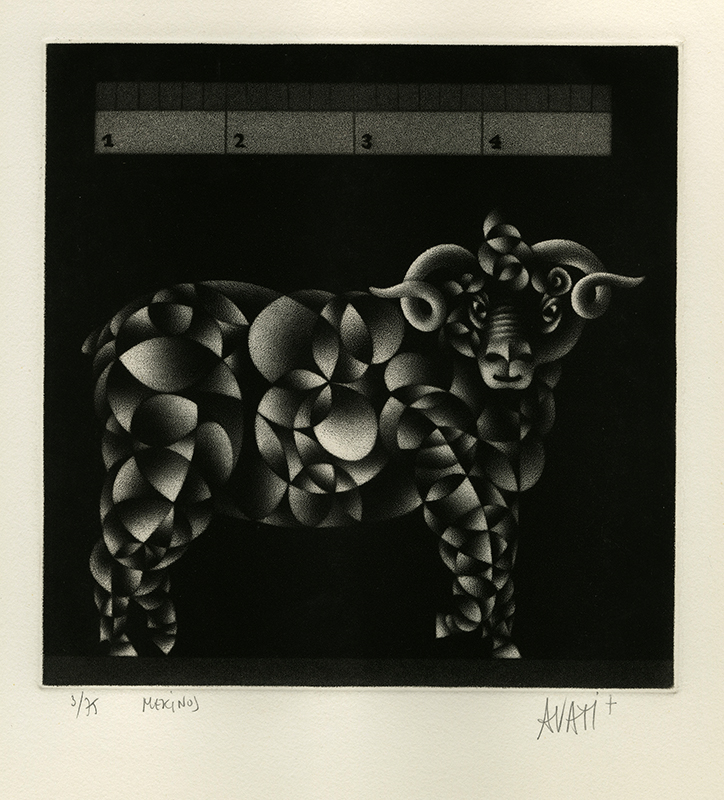Merinos is a mezzotint from 1971 by Mario Avati. It is pencil signed, titled and editioned 3/75. Merinos was included in the suite of mezzotints, Noah’s Ark, published by the Ferdinand Roten Gallery and bears the blindstamp of Roten in the lower left. Merinos was printed by the artist at Aquarius Press on ivory Rives BFK wove paper and the platemark measures 8-1/2 x 8-3/8 inches.
In the Avati catalogue that she composed for William Greenbaum Fine Prints, Marthe Outcault wrote: He painted, primarily monochromatic pictures, and explored the possibilities, both technical and expressive, of all the printmaking media from engraving to woodcut. He was, he says, looking for a certain quality of black, which none of these processes produced. When in 1950 he happened upon mezzotint, he understood that he’d found the black which would permit him to “create his universe.” While others marvel at his technical mastery of this difficult medium, Avati feels that the difficulty of the medium benefits him. The strict discipline demanded by the process’ slow, orderly progression from dark to light, maniere noire, required total attention, with no possibility of relaxation. A mistake requires beginning anew, thus nothing is left to chance. Technique, Avati says, is not significant in and of itself, but its mastery is important. Progressing technically, one also progresses expressively—what is said, and what can be said, is dependent upon how it is said.
Mario Avati, printmaker, painter, and book illustrator, was born to Italian parents in the Principality of Monaco on 27 May 1921. He studied at the École Nationale des Arts Decoratifs in Nice and the École nationale supérieure des Beaux-Arts in Paris. He began exploring the techniques of etching and aquatint in 1947 but, by 1957, he had turned exclusively to mezzotint. He was internationally regarded as a master of the medium and aided in the revival of its popularity as a fine art.
Avati made over 400 prints and he illustrated deluxe editions of books with original mezzotints (Lewis Carroll, Baudelaire, Villiers de l'isle-Adam, Brillat-Savarin, Nostradamus, the Bible, etc.). He was awarded the Prix de la Critique for drawing and printmaking in 1957, a Gold Medal at the First International Exhibition of Graphic Art in Florence in 1969, the Lions Club Award, Florence in 1972, the Grand Prix of Arts of the City of Paris in 1981, and the Nehed Ojjeh prize of the Académie des beaux-arts in 1997. Avati was a member of the Société des peintres-graveurs français and his work was included in countless solo and group exhibitions in museums and public institutions internationally.
His works are represented in more than 100 public collections including the Musée des Beaux Arts, Brussels; the Art Institute of Chicago; the Uffizi, Florence; the Kunstmuseum, The Hague; the Victoria and Albert Museum, London; the Metropolitan Museum and the Museum of Modern Art, New York; and the Library of Congress and the National Gallery, Washington, D.C.
Mario Avati lived and worked in Paris and he died there on February 26, 2009.
In 2013, the first Mario Avati Engraving Award was presented by the Académie des Beaux-Arts to an artist who contributed to the progress of the art of engraving.



